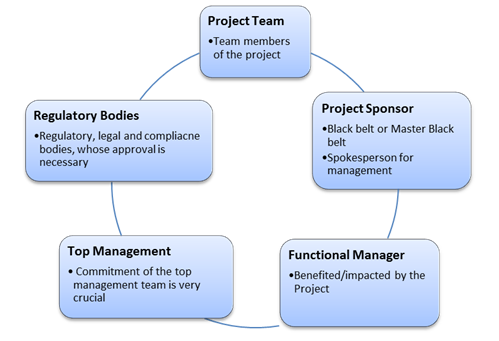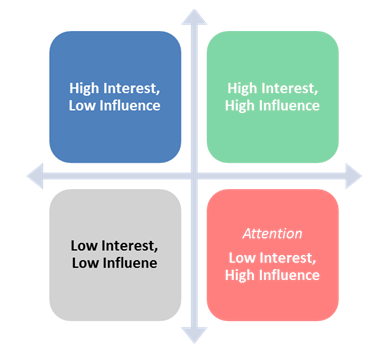Success of a Six Sigma Project starts with commitment from its stakeholders. Hence, one of the important steps in doing a Six Sigma project is Stakeholder Management. Stakeholder Management is the process of:
- Identifying the relevant Stakeholders
- Getting their buy-in for the project & changes
- Communicating the Stakeholders on the progress
Now, a question arises.
Who is a Stakeholder? How do I identify them?
It is a very simple and easy process.
Stakeholder(s) is a member or a team, who influences (or) is influenced by the outcome of the project. The member can be a part of the organization or can be an outside member.
Identifying the relevant Stakeholders
Your project Stakeholder will necessarily be some or all of the following categories:
Project Team:
- It is the Six Sigma Project Team which is involved in doing the project. They are a team comprising of Six Sigma experts, Domain experts, core operations team members, Quality Analysts etc. They know the whole reason for the project, are aware of the minute details, possess high knowledge on the internal processes, and are trained on Six Sigma. They should be provided with necessary resources for the success of the project.
Project Sponsor:
- One, who evaluates the cost-benefit of the project, approves the need for the project. This role is typically held by a Black-belt or Master Black Belt. When there is more than one project available to be chosen, he prioritizes the projects based on the cost incurred & benefits reaped by the individual projects. He acts as the spokesperson of the project for the entire organization. He also oversees the progress of the project and performance of the team members and intervenes if there is a slack or any bottlenecks, to provide necessary assistance.
Functional Head/Manager:
- This is the one who will either be benefited or impacted by the success or failure of the project. He should be convinced on the need for the project, its outcome and the changes. Hence, his buy-in on the project is very crucial for the project. Also, he provides financial support for the project.
Top Management:
- Not only in the Six Sigma project, but in any new initiative taken in an organization, buy-in and commitment of top management is very important. Without this, no initiative can yield success even with greatest efforts from the team. Therefore the Six Sigma project success follows a Top Down Approach – Top Management being at the Top and the Project Members at the bottom.
Regulatory Bodies:
- Apart from the internal Stakeholders discussed earlier, people outside the organization may also be impacted by the project. The organization, may have to get the approval of Regulatory or Legal entities (like Pollution Control Board), and may provide/maintain evidence for compliance of certain regional laws. Hence, these bodies are also the Stakeholders who should be kept informed of the project status and outcomes, records, documents etc.
This will help you in identifying the Stakeholders for the project. As per their responsibilities in the organization, the project leader then should determine their roles and contributions to be made to the project. A Stakeholder table with their contact details, roles and responsibilities is then defined and maintained.
Getting the Stakeholder Buy-in
A project having the following impact will by and large catch the attention of the Top management: Any project that increases revenue, customer satisfaction, sales, quality and that decreases the cost and defects. So a Black Belt should project the benefits of the project in the above terms, so that the project gets the necessary attention and support.
Apart from the above benefits a Function head would also be interested in i) Waste reduction ii) Process simplification etc.
Regulatory bodies would be interested in compliance of the product/service as per the guidelines provided by them.
Stakeholder analysis should also be done, to identify and prioritize the key Stakeholders and get their support. A grid of the Stakeholder Interest versus Influence (Power) of the Stakeholder on the project can be drawn, like below:
Stakeholders who have high influence in the organization – Red & Green girds (Can be a potential support in implementing the project without out any hassles), should be targeted and be convinced on the necessity of the project. The Black Belt should take necessary steps in getting their buy-in.
Communicating the Progress
While Project team and Sponsors are inclusive part of the project, the other Stakeholders are not so and may not know all the details of the project. They should be kept informed of the necessary information at an appropriate frequency.
Not all details are necessary for all Stakeholders. While Revenue details are of utmost importance to the Investors, it is not of any relevance to the regulatory bodies. Vice versa, Compliance report on every single aspect is necessary to the Regulatory bodies, but the top management only needs a summary on the Compliance %, and Non-compliant items with reasons and actionable items. So communicating the right details to the relevant person at the right time is the crux of Stakeholder Communication.
Now, Stakeholder management is an easy and simple task. This holds good not only for Six sigma projects but for any other organizational initiatives.


